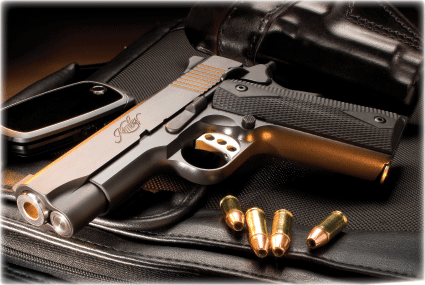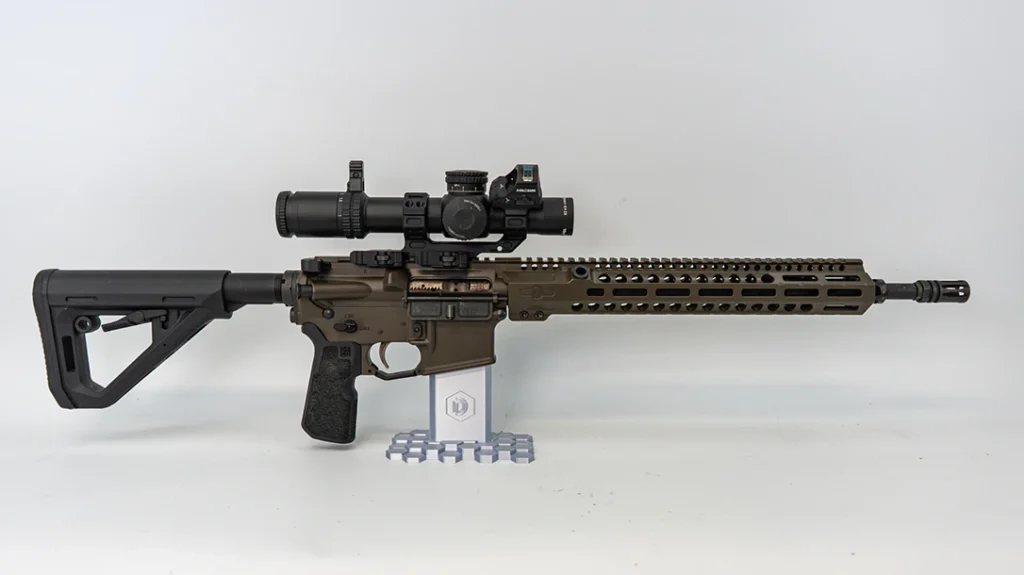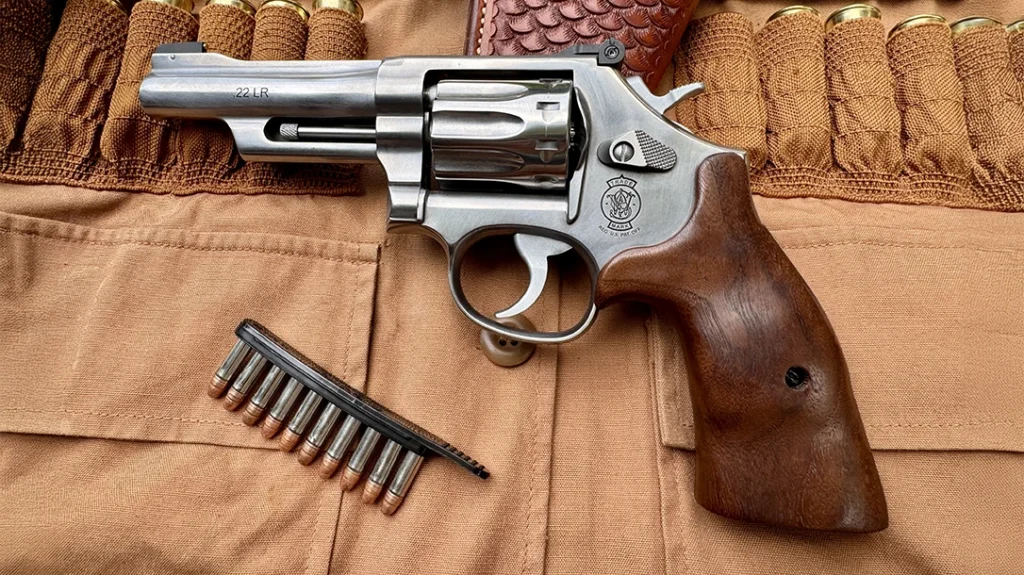Kimber’s Pro Carry II in 9mm is a 4-inch rendering of John M. Browning’s masterpiece finished entirely in subdued black self-lubricating “KimPro II” finish. The Pro Carry II is my favorite of their pistols for its balance, handling, drawing, and concealment properties. Kimber sent the gun to me for test and evaluation by accident, but after conversing with them on the phone about it, I told them I was always up for another pistol, especially the Pro Carry II.
Gun Details
Upon arriving in the usual lockable padded hard polymer case, initial inspection of the gun revealed that it 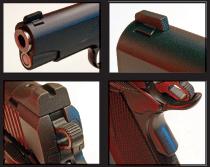 exhibited the usual excellent fit and finish that we’ve come to expect from Kimber. Sights and edges were broken or smoothed to eliminate most sharp edges. The slide-to-frame fit was tight with no discernable play, and I was unable to move the barrel downward with the slide in battery. The trigger had only a minute amount of vertical movement.
exhibited the usual excellent fit and finish that we’ve come to expect from Kimber. Sights and edges were broken or smoothed to eliminate most sharp edges. The slide-to-frame fit was tight with no discernable play, and I was unable to move the barrel downward with the slide in battery. The trigger had only a minute amount of vertical movement.
The Pro Carry II’s forged steel slide has rear-cocking serrations only. The ejection port is lowered and flared, and the tried-and-true “internal” extractor is employed. Kimber’s low-profile fixed combat sights are mounted in dovetails. The slide is roll-marked with the Kimber logo on the left side, and “Pro Carry II” on the right.
Advertisement — Continue Reading Below
The match-grade ramped barrel is a one-piece, steel button-broached unit with a 1-in-16-inch left-hand twist and an 11-degree crown. A notch at the rear of the barrel serves as a visual indicator of chamber-loaded status. The barrel is coned to directly contact the slide, eliminating the need for a bushing. A reverse recoil spring plug receives a guide rod, which works in tandem with a 14-pound recoil spring.
The frame is machined from a solid block of lightweight 7075-T7 aluminum forging. The aluminum frame shaves roughly 7 ounces from the weight of a similar steel-framed gun. The frame has a high relief cut under the triggerguard. This feature, combined with a bumped, up-swept beavertail grip safety, is designed to contribute to recoil control and reduced shot-to-shot times. I found the grip safety to be nicely fit and blended with the frame. The front strap is smooth, and the magazine well beveled for fluid reloads. Mainspring housing is a flat checkered, 20 lines-per-inch (lpi) polymer unit. Finish on the frame is matte black, and grip panels are double-diamond checkered black rubber, secured by hex-head screws.
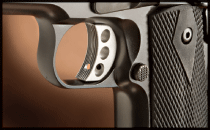 For shooters who are worried about the durability of the alloy frame, these concerns are unfounded. Kimber’s frames have been tested to over 20,000 rounds without evidence of meaningful wear. Furthermore, the Pro Carry’s fully supported barrel means that rounds impact and feed directly into the barrel, rather than a traditional anodized frame throat. The gun is, in fact, rated for +P and +P+ ammunition, though a shooter should consider decreasing the intervals at which the recoil spring is replaced if a steady diet of +P and/or +P+ ammo is used. A heavier recoil spring is also recommended.
For shooters who are worried about the durability of the alloy frame, these concerns are unfounded. Kimber’s frames have been tested to over 20,000 rounds without evidence of meaningful wear. Furthermore, the Pro Carry’s fully supported barrel means that rounds impact and feed directly into the barrel, rather than a traditional anodized frame throat. The gun is, in fact, rated for +P and +P+ ammunition, though a shooter should consider decreasing the intervals at which the recoil spring is replaced if a steady diet of +P and/or +P+ ammo is used. A heavier recoil spring is also recommended.
Advertisement — Continue Reading Below
The trigger has a long three-hole aluminum shoe with a serrated face, and is set at the factory between 4 to 5 pounds. The one on my sample broke crisply at 3.75 pounds with about 0.06-of-an-inch of take-up and very little creep.
The hammer is a skeletonized spurred unit, thumb safety is serrated and extended with no sharp edges. An extended, checkered magazine release is installed, and the slide stop is a standard GI-style serrated type. Slide stop, thumb and grip safety, magazine catch, disconnector, sear, hammer and strut are all MIM (metal injection molded) parts.
Overall an attractive pistol, its matte black finish and black sythetic grips lend the gun a subdued “covert” appearance, a very utilitarian quality for a concealed carry pistol.
Advertisement — Continue Reading Below
Range Time
We took the Pro Carry II 9mm to the range along with ammunition from American Eagle, Black Hills, CorBon, Extreme Shock, Federal, Hornady, MagTech, Remington and Winchester. Once there, we set up Birchwood Casey’s 8-inch “Dirty Bird” targets at 25 feet in preparation for accuracy testing. Five-round groups were fired from a freestanding position.
 Being accustomed to firing 1911s in .45ACP the vast majority of the time, the first thing that became readily apparent is that the Pro Carry II in 9mm has very minimal recoil. Standard Kimber features like the high cut under the triggerguard and the high beavertail grip safety allows the pistol to sit lower in the hand, reducing muzzle flip. The rubber grips lend a secure grasp on the pistol, together with the checkered surface of the mainspring housing. The bottom of the beavertail flares out at the bottom, and we had no problems disengaging it with a thumb-high grasp on the pistol.
Being accustomed to firing 1911s in .45ACP the vast majority of the time, the first thing that became readily apparent is that the Pro Carry II in 9mm has very minimal recoil. Standard Kimber features like the high cut under the triggerguard and the high beavertail grip safety allows the pistol to sit lower in the hand, reducing muzzle flip. The rubber grips lend a secure grasp on the pistol, together with the checkered surface of the mainspring housing. The bottom of the beavertail flares out at the bottom, and we had no problems disengaging it with a thumb-high grasp on the pistol.
A better trigger doesn’t literally make a pistol more accurate, but it makes it easier to shoot accurately. The light, crisp break on this pistol made its contribution toward putting the rounds were I aimed them.
Advertisement — Continue Reading Below
The soft recoil and lessened muzzle flip made getting tight groups simple. This was easily one of the most accurate 1911s I’ve handled, funneling five rounds of Hornady’s 147-grain TAP CQ into just 0.44 of an inch. Next-best patterns came from MagTech’s 124-grain FMC and Remington’s 124-grain Golden Sabers at 0.50 and 0.69 of an inch, respectively. The largest group all day was 1.38 inches, and the average only 0.95 of an inch.
We followed this accuracy testing with some double-taps and controlled pairs. The climb of the second shot during double-taps was minimal, as was the time between shots during controlled pairs; the sights quickly settled back down onto target.
Magazines dropped free and the extended release was easily manipulated, though not pronounced enough to be depressed accidentally. Reloads went smoothly, owing to the beveled magazine well, another Kimber standard. The cocking serrations were cut deep enough to grasp solidly while racking the slide. The Pro Carry II’s extended thumb safety clicked positively on and off, lessening the possibility that it might be inadvertently knocked off during carry. Some prefer an ambidextrous safety, but the standard right-handed configuration is much less likely to snag on concealment garments or, worse yet, harpoon itself into clothing. I’ve personally experienced these problems with ambidextrous safeties.
Advertisement — Continue Reading Below
The low profile sights were zeroed out of the box, impossible to snag, and yet easily and quickly picked up by the eyes.
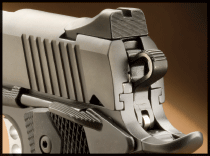 Perhaps most significantly, the gun hammered away all day long, never failing to feed, eject, or lock the slide to the rear after emptying the magazines. Some compact 1911s have a tendency toward malfunctions due to the difference in slide velocity intrinsic to the shorter slides when +P ammunition is used; this wasn’t the case with the Pro Carry II 9mm, which ran smoothly with +P offerings from CorBon. The only thing that would have made this gun better would have been the addition of night sights and a checkered front strap, but then again, a simple switch to Kimber’s Tactical Pro Carry II would get you these added features.
Perhaps most significantly, the gun hammered away all day long, never failing to feed, eject, or lock the slide to the rear after emptying the magazines. Some compact 1911s have a tendency toward malfunctions due to the difference in slide velocity intrinsic to the shorter slides when +P ammunition is used; this wasn’t the case with the Pro Carry II 9mm, which ran smoothly with +P offerings from CorBon. The only thing that would have made this gun better would have been the addition of night sights and a checkered front strap, but then again, a simple switch to Kimber’s Tactical Pro Carry II would get you these added features.
Final Thoughts
This pistol was a real tack-driver, quick, accurate, wholly reliable, and soft shooting. Its compact size makes it easily carried and concealed, and its 9mm chambering adds a new dimension to the ageless 1911 design, its dramatic reduction in recoil enhancing control to a great extent. The 4-inch configuration makes it handle and point well.
Advertisement — Continue Reading Below
Loaded with defensive ammo, the Pro Carry II 9mm would be appropriate for carry, or otherwise equally at home as a range gun. Kimber has yet another star in its Pro Carry II line.
For more information contact: www.kimberamerica.com
